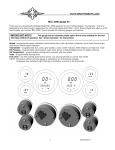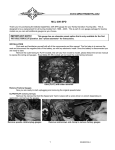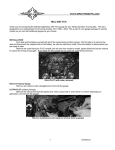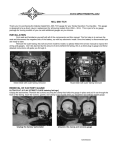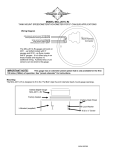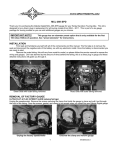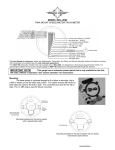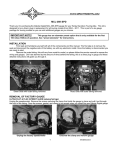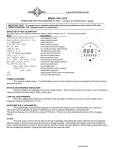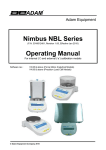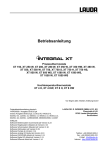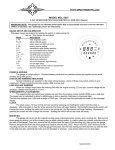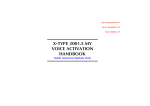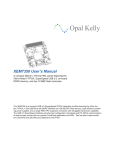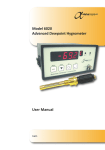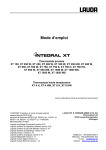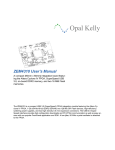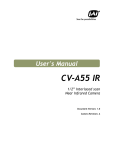Download 650226c MCL-3000 SPD_with cable
Transcript
MCL-3000 gauge kit Gauge kit for 1996-2003 Models Thank you for purchasing the Dakota Digital MCL-3000 gauge kit for your Harley Davidson Touring bike. This kit is designed to be a direct, plug in replacement for all touring models, from 1996 – 2003. Dakota Digital also offers a kit for newer models, part MCL-3006-OT. The kit includes the following gauges and features: IMPORTANT NOTE! This gauge has an odometer preset option that is only available for the first 100 miles (160km) of operation. See ‘‘preset odometer’’ for instructions. Speed - programmable speed calibration, performance menu, two trip meters, odometer, count down service miles, security and check engine lights Tachometer – programmable tach, clock, gear position, cruise indicator light, high rpm recall Oil Pressure – programmable warning point, uses stock sensor or Dakota Digital sensor for higher pressure Oil Temperature – programmable warning point, complete with new sensor Volts – programmable warning point Fuel Level – uses factory sensor, low fuel warning, can be programmed for custom fuel sender NOTE: The factory ambient air temp gauge is replaced by an oil temperature gauge. All gauges have automatic night dimming controlled by a sensor in the tachometer. 1 MAN#650226:B INSTALLATION First read and familiarize yourself with all of the components and this manual. The first step is to remove the seat and disconnect the negative side of the battery, as with any electronic install. Once the battery is disconnected you are ready to start. Remove the outer fairing; this will vary from model to model, please follow the service manual to expose the wiring and gauges. Don’t be alarmed by the amount of wires behind the fairing, this is a direct plug in kit and these detailed instructions will guide you through it. Ultra (FLHT) with outer removed Road Glide (FLTR) outer removed Remove Factory Gauges Now you are ready to start unplugging and removing the gauges. Start with the speedometer and tachometer gauge plugs and speedometer cable if you are working on a cable drive bike(1996-1999). ULTRA FLHT (batwing fairings) Remove the clamps that hold the Speed and Tach in place with a screw driver or wrench depending on application, and remove the gauges. Remove speedo cable/unplug gauges Remove nuts/screws and clamp to remove factory gauges ROAD GLIDE FLTR You will need to remove the speedometer and tachometer instrument bezel. To do this, remove two small screws on the left and right side of the bezel. Then lift up on the back of the bezel and slide the tab that is under the ignition switch out from under the switch cover, see photos below of ignition switch cover removed to show detail. Now unplug the gauge connections (cable where applicable). Remove switch, and unplug the idiot lights so the bezel can be completely removed for easier installation of the new gauges. Remove the clamp(s) that hold the gauges to the bezel and remove the gauges and grommets/gaskets. Picture of tab (switch cover removed) Bezel removed 2 Gauges/Grommets removed MAN#650226:B All of the small gauges, fuel, volts, oil, and air temp have two plugs. One is for illumination and the other is for the gauge power, ground, and sensor. The illumination harness, two pins (orange and black wires), will not be reused and can hang freely inside the fairing, with the bulb removed, or can be secured to the other gauge wires to clean things up. The three pin connector will be used to connect all of the new Dakota Digital small round gauges. Unplug connectors at the back of the 4 small round gauges, then remove the two 5/16” nuts holding the clamps onto each small gauge and remove the gauges. *New nuts for the small gauges are included in the hardware pack DO NOT reuse the stock nuts for the new gauges they are not the same thread. Removal Tip for FLH’s: It is recommended to leave the mounting bracket in place on the lower two gauges and then push the gauge out the front of the fairing and disconnect the wires in front of the faring so things can be reached a little easier. Reconnect the factory three-pin connector to the new oil pressure gauge and also route and connect the new two-pin switch & dimming connectors before installing the gauges. On the temperature gauge you will also want to install the oil temp sensor so the pin swapping can be performed and reached a little easier. Remove the small gauges with 5/16” wrench or nut driver IMPORTANT NOTE! SAVE ALL CLAMPS FROM THE FOUR SMALL GAUGES AS THEY WILL BE USED TO SECURE THE NEW DAKOTA DIGITAL GAUGES SAVE these clamps to secure new gauges Install New Gauges Note: This step is only for those with out a factory switch or cable drive applications since the switch was mechanical and attached to the speedometer. Now is a good time to install the function switch for cable drive applications, it can be hard to mount once the gauges are installed. Remove the rubber boot, insert the switch from the back of the fairing and then tighten the rubber boot on from the front. 3 MAN#650226:B Next you are ready to install the new gauges into the fairing. The new speedometer and tachometer come supplied with new gaskets and clamps. Install the gauges and secure using the supplied clamps and gasket on the speedometer and tachometer, reusing the old clamps on the small gauges securing the clamps with the supplied nuts. The picture on the first page shows the proper location for each gauge. Be sure the alignment tab on the clamp lines up with the notches in the fairing. Some fairings may only have one notch, line up at least one tab on the clamp with the notch in the fairing, this will insure the gauges are centered and aligned correctly. Speedometer and Tachometer Oil PSI, Oil Temp, Voltmeter, and Fuel Level WIRING (plug in connections) Now you are ready to make the gauge connections. Included in the kit is an adaptor box that allows the kit to directly plug into the factory harness. The box has several connections which are explained here. The adapter box will lay inside the fairing behind the speed and tach. The box can be secured to the wiring to prevent rattling. First locate your speedometer and tachometer connectors in the factory wiring harness that where unplugged from the original speed and tach gauges. Plug these connectors into their correct locations on the adaptor box. The adapter box has one set of connectors for 1996-1999 applications and another set for 2000-2003. For cable driven speedometers you will also need to wire in a speed sensor. If you have provisions for a transmission mounted sender use Dakota Digital SEN-1017, if not use Dakota Digital SEN-1011 a cable driven speed sensor. Wiring of the speed sensor will be done using the supplied 3 wire pigtail that connects to the adaptor box. The speed sensor pigtail should have a Red, Black, and White wires with a 3 pin connector. The speed sensor will need to be connected to the pigtail following the table below. Cut the red wire back if using the cable drive adaptor SEN-1011 since it is not used. Pigtail Black White Red SEN-1011 Black White 4 SEN-1017 Black Green Red MAN#650226:B If you are using the cable driven adaptor you will also need to pull the speedometer cable from the front wheel and replace the cable nut with the supplied cable nut so your speedometer cable will thread onto the new sender. You have to take the cable off at the wheel so the nut can slide down and off the end of the cable and allow the new nut to slide on. After the nut has been replaced the speedometer cable can be connected back to the wheel and also to the sender. Secure the sender with a zip tie and make sure there is no binding in the cable and that the cable has engaged fully into the sender. Speedometer and Tachometer connectors To connect the adapter box to the speedometer and tachometer you will need the supplied “Y” harness (this may already be connected to the adapter box). This harness has one 16 pin connector and two 10 pin connectors. The adapter box will attach to the 16 pin connector. The tachometer will attach to the 10 pin connector with a long orange wire hanging off it and will have a total of 8 wires. The speedometer will attach to the 10 pin connector with 9 wires in it. Clock Memory connection You will need to locate a fused, constant +12V battery power wire for the orange, clock memory wire. The long, orange, clock memory wire is located on the tachometer gauge plug. Check your service manual or use a voltmeter or test light to find and verify a constant power location. One common location to pick up the constant power is pin #10 on the radio. This should be a Red w/Orange wire that is fused to the battery. Oil Pressure, Voltage, and Fuel Level connection There are four two pin harnesses that are coming out of the adaptor box with a blue and green wire in each. This will plug into the back of each small round gauge, these wires are the switch(green) and dim(blue) wires. Route one of these harnesses to the back of each small gauge and plug it in. It does not matter what harness goes to what gauge as they are all the same. Now you can plug in the 3 pin power and sender connections for the small gauges. Plug the original oil pressure, voltage, and fuel connectors directly into the new gauges. Oil Temperature connection The air temperature gauge is replaced with an oil temperature gauge and this connector will need to be changed, instructions on how to install and connect the sensor begin on the following page. OIL TEMPERATURE SENSOR Evolution Engines The supplied temp sensor will need to be used with the included brass adaptor bushing(1/2” straight to 3/8 npt). You will need to use the supplied adaptor and install it in place of the oil drain plug. The new adaptor and sensor will now be the drain plug and will have to be unplugged and removed for oil changes. The factory o-ring is used to seal the adaptor to the pan and should be replaced at oil changes. First install the new o-ring, and thread the sensor into the adaptor. Once the sensor is tight it should be about flush with the end of the adaptor bushing, see photos below. 5 MAN#650226:B Oil temp sensor, adaptor bushing, and o-ring EVO temp sender assembled Twin Cam Engines The supplied oil temperature sensor replaces one of the oil pan plugs in twin cam engines. Oil Temp sensor and harness Now you are ready to install the sensor into the oil pan. You can do this at an oil change so you do not have to worry about losing oil, or if done quickly you should only lose a small amount of oil. First locate the allen head plug on the front bottom side of the oil pan, or the drain plug. The plug for twin cams is on the left of the oil pan drain plug that is used to drain the engine oil for an oil change. It is a 3/8’’ NPT allen head plug that should be flush with the oil pan. See photo for the correct plug. Wipe any road grime and oil from around the sensor so the area is clean. Use a 5/16’’ allen wrench to remove the plug, or a ¾’’ wrench for the drain plug on EVO applications. Have the sensor ready to thread in so minimal oil is lost. Tighten down the new oil temp sensor with a ¾’’ wrench. NOTE: Check oil level after install of this sensor, refill oil as needed 6 MAN#650226:B Bottom of oil pan Remove 3/8”npt allen plug Thread sender into oil pan Installed oil temp sensor and harness plug TC Tighten temp sensor with a ¾” wrench Temp sensor installed as drain plug EVO Plug in the sealed two pin connector and route the wires over to the bottom right side frame rail. Begin running the wires back and up behind the transmission and starter area to the battery box, following the wiring harness that is in place. Use zip-ties to secure the wire harness to the other wires along the frame. 7 MAN#650226:B Once you have the wires up through the battery box area it is recommended you remove the tank bolts to continue running the harness under the tank to its final destination behind the fairing. Use a firm wire and some electrical tape to fish the wires up the backbone under the tank(filler rod/welding wire works well for a fish tape). Once clear of the tank, follow the factory wiring harness on the right side and route wires behind the fairing and over to the oil temp gauge. Make sure to replace and tighten the tank bolts when done. Remove rear tank bolt Route wires under tank Remove front tank bolts to loosen tank Pull the temp sensor wires through the fairing Now you will have to de-pin a couple wires to connect the temp sensor wires to the factory plug to allow a factory style plug in connection to the gauge. The pins in the connector have a small locking tab on the back flat side of the terminal seen in the picture below. Use a small allen wrench/pick/or small screw driver to bend and release this tab. While pushing on the tab, pull the wire gently out from the back of the connector. You will need to remove: Black pin 2 gauge ground(bottom center location in the housing) Blue w/ Violet pin 3 gauge signal (old air temp sensor, right location looking at back of housing) Insert the RED wire into the previous location of the Blue w/ violet wire. Insert the other BLACK wire with a short 3’’ pigtail into the black wire’s previous location. Slide supplied piece of heat shrink over the pigtail and connect the spade connector on the black wire to the original gauge ground wire that was removed from the housing. This provides ground for the gauge and sensor. Heat up the heat shrink to protect the ground connection. NOTE: See Photos on the following page for more details 8 MAN#650226:B Locking tab on terminals Using a small allen/pick release the locking tab Push gently on the tab to release pin Remove the pin from the connector Oil Temp Sensor Plug Connections 9 MAN#650226:B FUNCTION SWITCH The push button function switch mounted beside the speedometer allows access to all of the mileage, rpm, and performance information. Pressing and releasing the function switch toggles through the different displays. Pressing and holding the switch for about 2 seconds will reset the current display. The display sequence is as follows: SPEED MENU 000000 odometer mileage A 000.0 trip meter mileage A trip meter mileage B B 000.0 S 0000 count down to service (if programmed) ++++++ Speedometer will show km/h (or MPH if metric) PERFORMANCE MENU HI 00 high speed recall 60 00.0 0-60mph time (0-100kph) 25 00.0 quarter mile time 25 00 quarter mile speed The 0-60 and ¼ mile timers are zeroed by pressing and holding the switch while that timer is displayed. The timer will not restart until the speed reaches zero and then you start driving again. The function switch can also be used to change the tachometer display. Make sure the speedometer is displaying the odometer to avoid resetting any of the other settings before attempting to change the tachometer. Press and hold the switch for about 4 seconds to change the tach menu. Press and hold the switch for about 6 seconds to reset the high rpm recall while it is displayed. The tachometer only has two display modes as follows: TACH MENU CLOCK > 12:00 12 hour clock HI RPM > 0000 high rpm recall GAUGE SETUP AND CALIBRATION The function switch, discussed above, is used to enter setup mode for all of the gauges. The first step in the setup procedure is to select which gauge you are going to select to change a setting. Each gauge will either show a number or a label. If the gauge is showing a label then that gauge will be selected to enter setup. All of the other gauges will exit setup and allow the selected gauge to be changed. To get into setup press and hold the function switch while turning the key on. Press and release the switch to advance through the menus below, when on the desired option press and hold the switch to select setup for that particular gauge/function. speed tach oil psi oil temp Fuel volt st 1 - 1 CL - 1 - 1 - 1 - 1 nd 2 SPd - 2 - 2 - 2 - 2 - 2 rd 3 - 3 tCH - 3 - 3 - 3 - 3 th 4 - 4 - 4 PSI - 4 - 4 - 4 th 5 - 5 - 5 - 5 F or C - 5 - 5 th 6 - 6 - 6 - 6 - 6 FUL - 6 th 7 - 7 - 7 - 7 - 7 - 7 uLt th 8 - 8 - 8 - 8 - 8 - 8 - 8 FACTORY DEFAULT SETTINGS FOR SETUP MENUS Below is a list of all of the factory gauge settings and what can be adjusted in the setup menus. You can calibrate and adjust gauges as often as you wish, however they should only need to be set once. Most gauges will function properly from the factory, only desired warning points will need adjustment. The fuel sender needs to be set per application as well. The only gauge that may require setting after the initial install is the Clock function on the tachometer so it is the first setup menu. Speedometer Tachometer Unit Service meter Performance Menu MPH OFF ON Engine cylinders Signal type Night Dimming Display Update RPM Warning Pressure Gauge Sender HI warn Lo warn 60PSI (user selectable) 51 PSI (range varies with sender) 7 PSI (range 02-32 psi) 11.1 V (range 9.6-12.6) 15.4 V (range 13.9-16.9) Fuel Gauge Oil Temp Gauge Sender Hi warn Volt Gauge Lo warn Hi warn 2 12 HI (12V ignition signal) 1 (darkest) 3 (fastest 1/8 sec.) 5500 (range 2200-9900) Set to deg F (user selectable scale) 230 F (range 200-290F or 93-143C) 10 Sender Lo Warn 10 ohm sender (user selectable) 10% (not adjustable) MAN#650226:B SPEEDOMETER SETUP Main Menu Sub Menu Description SPD Avto select speed unit and auto calibrate speed AdJvSt select speed unit and adjust calibrate speed S SEt miles to service setting PErF enable/disable performance readings -odoMK one-time odometer preset (only shown while odometer has less than 100 miles) Until the speedometer is calibrated, the odometer display will show “PLEASE” “SET” “SPEED”. This message can be cleared temporarily by pressing and holding the switch. To enter the speedometer setup, press and hold the switch while turning the key on and starting the engine. Once the engine is running, release the switch. The speedometer will show “-1-“. Press and release the switch so that “SPd” is displayed. Press and hold the switch for about 3 seconds until “ - “ is displayed. Release the switch. The MPH display will show “SET” and the odometer display will show “AvTo”. Press and release the switch to move through the different menus, press and hold the switch to select a menu option. Note: The speedometer calibration and gear programming are the only functions that require you to hold the switch while starting the bike, and this is only if you are going to adjust the calibration since you will have to ride the bike. Some ignition systems may disrupt power to other circuits causing the gauge to reset, this is why you must hold the switch while starting if you are performing speedometer calibration. All other gauge functions and gauges can be set without running the engine. SPEED CALIBRATION There are two methods for calibrating the speedometer, auto cal and adjust. Either one can be used. Auto cal requires that you have one measured mile marked out (km for metric), this is the best method to start with if your speedometer needs a lot of correction. Adjust requires you to follow another vehicle going at a set speed, time your self over a mile to determine your speed, or use a hand held GPS with speed indication. AvTo Auto Cal • • • • Press and release the switch until “Avto” is displayed, then press and hold the switch until “ - “ is displayed. Release the switch. The display will switch to “vnit” and light up the current speed unit (MPH or km/h). Press and hold the switch to keep the current unit or press and release the switch to change the unit. Next the speedometer will display “CAL” and the message display will show zeroes. You should now begin driving the measured mile. The message display will count the number of pulses received from the sensor. The message display cannot be used to determine when a mile has been driven. Once you reach the end of your marked mile, press and release the switch again. The calibration is now done. ADJv ADJvST Adjust • • • • Press and release the switch until “AdJvSt” is displayed, then press and hold the switch until “ - “ is displayed. Release the switch. The display will switch to “unit” and light up the current speed unit (MPH or km/h). Press and hold the switch to keep the current unit or press and release the switch to change the unit. Next the system will restart with “AdJvSt” on the message display. The speedometer will show the speed reading. Begin driving at a known speed. When the switch is pressed, the speedometer reading will begin increasing until the switch is released. The next time the switch is pressed, the reading will begin decreasing until it is released. When the speedometer is correct you can release the switch. The new calibration will be saved if no adjustments are made for 10 seconds. PLEASE NOTE: Common problems during calibration: VSS (vehicle speed sensor) wires should be isolated from the ignition system. Coils, plug wires, or tachometer signal wires routed near or with the VSS wire can cause many problems. If you are seeing erratic speedometer operation, registering speed at a standstill, or speed changes with engine RPM, please double-check your VSS wire and tachometer wire routing making sure the VSS wire is separated from any ignition system components. If your speedometer registers ‘00 00’ 00 all the time, the unit is not receiving a VSS signal, please doublecheck your sensor wiring and mounting. The speedometer cannot be properly calibrated until you are registering a stable, but incorrect speedometer reading. Please see Speed sensor voltage checks on the last page for assistance in checking your sensor. 11 MAN#650226:C (Speedometer Setup Continued) S SET Miles to Next Service setup The service mileage is a countdown mile meter. The service mile display can be disabled or can be set to count down from 500 – 7500 miles. If the service mileage is enabled and it gets to 0 miles it will display “S -DvE” each time the key is turned on. If the push button switch is pressed and held while “S XXXX“ is displayed, the service miles will be reset to your preset. • Press and release the switch until “S XXXX” is displayed, then press and hold the switch until “ – “ is displayed. • Release the switch. The current setting will be displayed, “OFF” or a mileage from 500 – 7500. • Press and release the switch until the desired setting is displayed. • Press and hold the switch until “ - ” is displayed. PERF Performance menu setup The performance readings can be turned on or off. When they are turned off the odometer will only toggle through the mileage readings. • Press and release the switch until “PErF” is displayed, then press and hold the switch until “ - “ is displayed. • Release the switch. The current setting will be displayed (on or oFF). • Press and release the switch until the desired setting is displayed. • Press and hold the switch until “ - ” is displayed. odoMK Odometer preset The odometer can be preset by the customer within the first 100 miles. Once the odometer has more than 100 miles the menu option will no longer be displayed. Make sure you have first calibrated the speedometer and correctly selected the units to be either MPH or km/h first. The odometer will be set in the selected units. Once you have preset the miles you cannot change it again. WARNING!!: This only allows setting odometer to the nearest mile. Do not use tenths! For example a mileage of 65432.1 should be set to “065432” using this method. If the tenths digit is used, the odometer will read 10 times too high. • Press and release the switch until “-odoMK” is displayed, then press and hold the switch until “ - “ is displayed. • The current miles will be displayed with the left most digit flashing. • Press and release the switch to increment the digit. Press and hold the switch to move to the next digit to the right. • Continue until the right most digit has been set. Press and hold the switch and the speed display will show “No“. • Press and hold the switch while “no” is displayed to go back and continue changing the odometer display. Turn the key off to cancel any changes. • Press and release the switch to change to speed display to “yes”. Press and hold the switch while “yes” is displayed to save the current odometer reading. TACHOMETER SETUP Main Menu CL tCH Sub Menu Description set clock time nigHt set night dimming level t CAL set engine cylinder setting vPdAtE set rpm update rate for digital readout WXArN set rpm shift warning point geAr transmission gear programming SIgnAL select 12 HI (normal) or 5 LO (low voltage) tach signal The gauge can be set to read from 1-15 cylinder ignition signals. It can also be set to read either 12 volt tach signals or 5 volt tach signals found on some engine computers. The digital tachometer update rate can be adjusted between slow, mid, and fast. The rpm warning/shift point can be adjusted from 2200 – 9900. The tachometer will read from 350 – 9,990 rpm. Press and hold the switch while turning the key on. Release the switch. Press and release the switch until “tCH” is displayed, then press and hold switch until “ – “ is displayed. The rpm display will show “Set” and the lower display will show “night”. Press and release the switch to move through the different menus, press and hold the switch to select a menu option. Note: The tachometer calibration may require you to hold the switch while starting the bike, only if you are going to adjust/set the GEAR programming since you will have to ride the bike. Some ignition systems may disrupt power to other circuits causing the gauge to reset, this is why you must hold the switch wile starting if you are setting up the GEAR display. All other gauge functions, and gauges, can be set without running the engine CL CLOCK SETUP • • • • • • The time is displayed on the smaller display below the RPM. It will not light up until the orange wire is powered. To set the clock, press and hold the switch while turning the key on. Release the switch. The RPM display should show “CL” , press and hold switch until “ - “ is displayed. Release the switch. The lower display will show the current hours. Press and release the switch to change the hours, press and hold the switch to change the minutes. Release the switch. The lower display will show the current minutes. Press and release the switch to change the minutes, press and hold the switch to save this and exit setup. 12 MAN#650226:C (Tachometer Setup Continued) nIgHt NIGHT DIMMING Your display system has a dimming feature that dims the display intensity. Normally the system is at full brightness for daytime viewing. The tachometer has a light sensor that will provide a signal to the other gauges to reduce the brightness at night. The level of darkness before the gauges dim can be adjusted in the tachometer setup. • • • Press and release the switch until “nIgHt” is displayed, then press and hold the switch until “ – “ is displayed. Release the switch. The update setting will be displayed. (1=late(darkest), 2=mid, 3=early(lightest), OFF). Press and release the switch until the desired setting is displayed. Press and hold the switch until “ - ” is displayed to save the setting. • • • • Press and release the switch until “t CAL” is displayed, then press and hold the switch until “ - “ is displayed. Release the switch. The current cylinder setting will be displayed. Press and release the switch until the desired setting is displayed. Press and hold the switch until “ - ” is displayed. • T CaL Engine cylinder setup vPdAtE Display update setup The display update will select how quickly the tachometer reading will respond. • • • Press and release the switch until “vPdAtE” is displayed, then press and hold the switch until “ - “ is displayed. Release the switch. The update setting will be displayed. (1=slow, 2=mid, 3=fast). Press and release the switch until the desired setting is displayed. Press and hold the switch until “ - ” is displayed to save the setting. • • • Press and release the switch until “WXArn” is displayed, then press and hold the switch until “ - “ is displayed. Release the switch. The current warning point will be displayed. Press and release the switch until the desired setting is displayed. Press and hold the switch until “ - ” is displayed to save the setting. • WXArn Rpm warning setup • gEAr Gear Indicator setup • • • • • • • • This tachometer has a single digit display for gear position. The gauge can learn the positions based on speed and rpm so no sensors are needed, just what you’ve already plugged in. It will work with 4, 5, 6 or 7 speed transmissions. To program the gear positions, begin at a section of road where you can gradually shift through all of the gears. Press and hold the switch while turning the key on and starting the engine. Once the engine is running, release the switch. Press and release the switch until “tCH” is displayed. Press and hold the switch until “ - “ is displayed. Press and release the switch until “gEAr” is displayed, press and hold the switch until “ - “ is displayed. The message will show “LO TCH” if the engine rpm is below 1500, or “LO SPD” if the vehicle speed is below 5. st Begin driving in 1 gear. The display should show GEAR 1 and the “1” should be flashing. Drive at a steady speed until the “1” stops flashing, it should only take about 20 seconds if the speed and RPMs are steady. Optionally: If the gear does not stop flashing you can manually override and jump to the next gear by pressing and releasing the switch to store the gear position quicker. nd Shift to 2 gear and drive at a steady speed. The display will change to a flashing “2”. Wait until the “2” stops flashing. then “3” should start flashing, shift to the next gear and continue. Optionally: If the gears do not stop flashing you can manually override and jump to the next gear by pressing and releasing the switch to store the gear position quicker. Repeat this through each gear. When you are done, come to a complete stop or press and hold the switch until the display shows “SETvP”. Turn the key off and then on again to restart the gauges in normal operation, verify the gear position by riding through each gear and seeing if positions agree. SIGNAL Tach signal setup • • • • Press and release the switch until “SIGnAL” is displayed, then press and hold the switch until “ – “ is displayed. Release the switch. The setting will be displayed. (12 HI or 5 LO). 12 HI is the normal setting. Press and release the switch until the desired setting is displayed. Press and hold the switch until “ - ” is displayed. 13 MAN#650226:C OIL PRESSURE SETUP The oil pressure gauge can be set for various stock Harley pressure senders. There is a display update setting for how fast the numbers will change, as well as a user settable low and high pressure warning points. When a warning condition is reached the gauge will flash the reading as a warning indicator. The stock sender for 2004 and up should be the 60 psi sender. For higher pressure and more accurate pressure readings one of two Dakota Digital senders may be used: 0-75 psi SEN-1032, or 0-150 psi SEN-1031 (sold separately). • • • • • • • • • • • To enter setup, press and hold the switch while turning the key on. Release the switch. The gauge will show “-1-“. Press and release the switch until “PSI” is displayed, then press and hold the switch until “Snd“ is displayed. Press and release the switch until the correct sender type is displayed. “40” for ’96-’98 stock sender, “60 60” 60 for ’99-up stock sender, “75” for Dakota Digital 75 psi, “150” for Dakota Digital 150 psi. Press and hold the switch until “LO” is displayed, then release the switch. Press and release the switch until the desired low pressure warning point is displayed. Press and hold the switch until “HI” is displayed, then release the switch. Press and release the switch until the desired high pressure warning point is displayed. Press and hold the switch until “SPd” is displayed, then release the switch. Press and release the switch to change the update rate between fast “FSt” and slow “SLO”. Press and hold until “---“ is displayed to save the settings. Turn the key off. OIL TEMPERATURE SETUP The oil temp gauge has a user selectable high temperature warning point that can be set so the gauge will flash the reading when the temp is met or exceeded. The gauge will only read correctly with the supplied sender. • • • • • • • To enter setup, press and hold the switch while turning the key on. Release the switch. The gauge will show “-1-“. Press and release the switch until “ F ” or “ C “ is displayed, then press and hold the switch until “Snd“ is displayed. Press and release the switch to change between Fahrenheit “F F” and Celsius “C”. Press and hold the switch until “HI” is displayed, then release the switch. Press and release the switch until the desired high temperature warning point is displayed. Press and hold until “---“ is displayed to save the settings. Turn the key off. FUEL SETUP The fuel gauge can be set to read the two common stock Harley sensors, see setup procedure below for correct sender selection. There is also a non-adjustable warning feature that will flash the gauge at any reading below 10% as a low fuel warning indicator. • • • • • • • • • • To enter setup, press and hold the switch while turning the key on. Release the switch. The gauge will show “-1-“. Press and release the switch until “FUL” is displayed, then press and hold the switch until “Snd“ is displayed. Press and release the switch until the correct sender type is displayed. “10 10” 33” 10 for 73-10, “33 33 for 240-33, “CUS” for custom or “CAL” for custom sender programming. The stock fuel sender should use the “10 10” 10 setting for correct readings. If “CAL” is not selected, press and hold until “---“ is displayed. Turn the key off. If “CUS” is selected, and a custom fuel curve has not yet been programmed, the gauge will immediately enter the “CAL” routine. If “CAL” is selected, the fuel sender curve can be programmed into the gauge. Begin with an empty tank. The gauge will be showing -00 and switch to displaying the measured resistance. Press and release the switch to save the empty reading. The display will show -33 and then switch to displaying the measured resistance. Add enough fuel to fill the tank to 1/3. Press and release the switch to save the 1/3 reading. The display will show -66 and then switch to displaying the measured resistance. Add more fuel to fill the tank to 2/3. Press and release the switch to save the 2/3 reading. The display will show -99 and then switch to displaying the measured resistance. Add more fuel to fill the tank full. Press and release the switch to save the full reading. Press and hold until “don“ is displayed to save the settings. The gauge will then return to normal operation. VOLT SETUP The volt gauge has user settable low and high voltage warning points that will make the gauge flash as a warning indicator when either of the conditions are met or exceeded. • • • • • • • To enter setup, press and hold the switch while turning the key on. Release the switch. The gauge will show “-1-“. Press and release the switch until “vlt” is displayed, then press and hold the switch until “ LO“ is displayed. Press and release the switch until the desired low voltage warning is displayed. Press and hold the switch until “HI” is displayed, then release the switch. Press and release the switch until the desired high voltage warning point is displayed. Press and hold until ì---“ is displayed to save the settings. Turn the key off. 14 MAN#650226:C Speedometer Troubleshooting guide. Problem Possible cause Gauge will not light up Red wire does not have power. Black wire is not getting a good ground. Gauge is damaged. Gauge lights up, but speed Gray wire is not connected properly. will only show zero. Speed sensor not grounded properly. PLEASE – SET – SPEED Speed reading is erratic or jumps around. Speed reading is incorrect. Gauge will not dim. Gauge remains dim at all times. Security indicator does not work. Engine indicator does not work. Speed sensor is not being turned by transmission. Sensor is not sending a speed signal. Gauge is not calibrated Speedometer not calibrated Speed sensor wire is loose or broken. Cable is loose or broken. Poor ground connection. Ignition Interference Gauge is not calibrated correctly. Blue wire (2-pin harness) is not connected correctly. Blue wire (2-wire harness) is getting power all all of the time. Loose or incorrect connection to indicator wire. Loose or incorrect connection to indicator wire. Solution Connect to a location that has power. Connect ground to a different location. Return gauge for repair. (see instructions) Check connection from gray wire to speed signal wire. Move ground to different location, preferable close to the speedometer ground. Check cable connection between sensor and transmission. Sensor can be tested by spinning the cable with a drill. Check for a damaged or malfunctioning speed sensor. Gauge must be recalibrated (see instructions). Gauge must be calibrated to your vehicle (see instructions) Check all wire connections and inspect wire for breaks. Check cable between sensor and transmission. Check ground connection on speedometer and sensor. Check for tachometer wires routed with VSS signal wires. Check for VSS signal wires routed near ignition coils Check for poor ignition system ground Use suppression spark plug wires Gauge must be calibrated (see instructions). Check wiring connections. Blue wire should have 12 volts when tachometer is dim. Check wiring connections. Blue wire should have 0 volts when tachometer is bright. Check that the appropriate indicator wire has about 0 volts when the it should be off and about 12 volts when the indicator should be on. Check that the appropriate indicator wire has about 12 volts when the it should be off and about 0 volts when the indicator should be on. Speed sensor voltage checks. All checks should be made with the sensor connected to the gauge and the key on. Checks should be done with a voltmeter and not a test light. Checks for the 3-wire sensor should be made between each individual wire and ground. 3-wire sensor: Red wire should have 9-11 volts dc, slightly less than battery voltage, (sometimes +5V if supplied by factory harness) Black wire should show ground, 0 volts dc at all times. White wire should vary between 0 and 5 volts dc as the gear teeth, or a steel object passes by the sensor. Aluminum and Stainless Steel will not work with a Hall-effect sensor. This can be checked with the sensor mounted and spinning the rear tire slowly, or by removing the sensor and moving a steel object pass the face of the sensor. 2-wire sensor: Measure the voltage between the two sensor wires. With the wheel spinning the voltage should be about 1-10 volts ac (make sure the meter is set to AC volts and not DC volts for this check). Tachometer Troubleshooting guide. Problem Possible cause Gauge will not light up Red wire does not have power. Black wire is not getting a good ground. Gauge is damaged. Clock will not light up Orange wire does not have power. Clock will not keep time Orange wire does not have constant power. Gauge lights up, but tach Yellow wire is not connected properly. will only show zero. Ignition system not grounded properly. Gauge is not grounded properly. Tach signal type is not set correctly. Gauge is not calibrated Tach reading is erratic or Tach signal wire is loose or broken. jumps around. Poor ground connection. Tach reading is incorrect. Gear indicator is always * Gauge will not dim. Gauge remains dim at all times. Cruise Engage indicator does not work. Update rate is too fast. Gauge is not calibrated correctly. Gears not programmed. Night dimming is turned off or too low. Night dimming is turn too high. Light sensor at bottom of gauge is covered. Loose or incorrect connection to indicator wire. 15 Solution Connect to a location that has power. Connect ground to a different location. Return gauge for repair. (see instructions) Connect to a location that has constant power. Connect to a location that has constant power. Check connection from yellow wire to tach signal wire. Check engine and ignition system grounds. Check gauge and engine grounds. Change the tach signal type (see instructions). Gauge must be recalibrated (see instructions). Check all wire connections and inspect wire for breaks. Check ground connection on tachometer, engine, and ignition system. Reset display update speed slower. Gauge must be calibrated (see instructions). Program gear indicator in setup. (see instructions) Change “night” setting in setup. (see instructions). Change “night” setting in setup. (see instructions). Make sure the lower part of the lens is not covered. Check that the appropriate indicator wire has about 12 volts when the indicator should be off and about 0 volts when the indicator should be on. MAN#650226:C Small gauge Troubleshooting guide. Problem Possible cause Gauge will not light up Orange wire does not have power. Black wire is not getting a good ground. Gauge is damaged. Gauge reading is erratic or Gauge signal wire is loose or broken. jumps around. Poor ground connection. Gauge reading is incorrect. Gauge is set up for wrong sensor type. Gauge will not dim. Blue wire (2-pin harness) is not connected correctly. Gauge remains dim at all Blue wire (2-wire harness) is getting power all times. all of the time. Gauge will not enter setup. Green wire (2-wire harness is not connected correctly. Solution Connect to a location that has power, check fuses. Connect ground to a different location. Return gauge for repair. (see instructions) Check all wire connections and inspect wire for breaks. Check ground connection on gauge, engine, and sensor. Change sensor setting in setup. (see instructions). Check wiring connections. Blue wire should have 12 volts when tachometer is dim. Check wiring connections. Blue wire should have 0 volts when tachometer is bright. Check wiring connections. Green wire should have 12 volts when the switch is pressed. WIRING COLOR CODE FOR SPEEDOMETER AND TACHOMETER: Color on GAUGE Stock harness color Function WHITE/RED varies with application speed sensor power out (if required)* WHITE/BLACK BROWN/VIOLET security system indicator GREEN connects to supplied harness switch input BLUE connects to supplied harness night dimming GRAY see VSS section speed signal input WHITE WHITE/GREEN output speed signal PINK BLACK/YELLOW engine indicator BLACK BLACK ground for gauge RED ORANGE/WHITE +12 volt power with key on ORANGE RED/ORANGE +12V battery power for clock YELLOW PINK tach signal input WHITE/GREEN GREEN/RED cruise set indicator *To avoid damage to motorcycle, please see Speedometer, Tachometer, and Status and Warning Indicators sections for details on locating VSS, Tachometer, and indicator wires for most motorcycle applications SERVICE AND REPAIR DAKOTA DIGITAL offers complete service and repair of its product line. In addition, technical consultation is available to help you work through any questions or problems you may be having installing one of our products. Please read through the Troubleshooting Guide. There, you will find the solution to most problems. Should you ever need to send the unit back for repairs, please call our technical support line, (605) 332-6513, to request a Return Merchandise Authorization number. Package the product in a good quality box along with plenty of packing material. Ship the product by UPS or insured Parcel Post. Be sure to include the RMA number on the package, and include a complete description of the problem with RMA number, your full name and address (street address preferred), and a telephone number where you can be reached during the day. Any returns for warranty work must include a copy of the dated sales receipt from your place of purchase. Send no money. We will bill you after repair. Dakota Digital 24 Month Warranty DAKOTA DIGITAL warrants to the ORIGINAL PURCHASER of this product that should it, under normal use and condition, be proven defective in material or workmanship within 24 MONTHS FROM THE DATE OF PURCHASE, such defect(s) will be repaired or replaced at Dakota Digital’s option. This warranty does not cover nor extend to damage to the vehicle’s systems, and does not cover removal or reinstallation of the product. This Warranty does not apply to any product or part thereof which in the opinion of the Company has been damaged through alteration, improper installation, mishandling, misuse, neglect, or accident. This Warranty is in lieu of all other expressed warranties or liabilities. Any implied warranties, including any implied warranty of merchantability, shall be limited to the duration of this written warranty. Any action for breach of any warranty hereunder, including any implied warranty of merchantability, must be brought within a period of 24 months from date of original purchase. No person or representative is authorized to assume, for Dakota Digital, any liability other than expressed herein in connection with the sale of this product. 16 MAN#650226:C
















